 |
PLATO'S ACADEMY
Academy was a suburb of Athens, named after the hero Academos or Ecademos. The site was continuously inhabited from the prehistoric period until the 6th century A.D. During the 6th century B.C., one of the three famous Gymnasiums of
Athens was founded here. Moreover, it is recorded that Hippias, the son of Peisistratos, built a circuit wall, and Cimon planted the area with trees which |
|
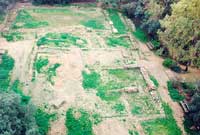 |
|
| were destroyed by Sulla in 86 B.C. In 387 B.C. Plato founded his philosophical school, which became very famous due to the Neoplatonists, and remained in use until A.D. 526, when it was finally closed down by emperor Justinian.
The first excavations on the site were carried out between 1929 and 1940 by P. Aristophron, at his own expense. Work was resumed in 1955 by Ph. Stavropoulos under the auspices of the Athens
Archaeological Society, and lasted until 1963. Since then, excavations have been conducted by the 3rd Ephorate of Antiquities. |
|
 |
|
PANATHENAIC STADIUM
It was originally a natural hollow part of the ground between the two hills of Agra and Ardettos, over Ilissos river. It was transformed into a stadium by Lykourgos in 330-329 BC for the athletic competitions of the Great Panathinaea Festivities. Between 140 and 144 AD, Herodes Atticus restored the Stadium, giving it the form |
|
| that was found at the 1870 excavation: the horseshoe construction with a track 204,07 meters long and 33,35 meters wide. It is believed that the Stadium had a seating capacity of 50.000 people. Separating scales were built between the tiers and on the base of the sphendone there was a portico with Doric-style columns; another portico was placed in the stadium's facade.
Herodes possibly restored also the Ilissos river bridge on the Stadium's entrance, making it larger and adding three archways on its base. The bridge was standing there up to 1778 and a part of it was excavated in 1958. At the Roman times, the Stadium was used as an arena, with the addition of a semi-circular wall on the north that was corresponding to the sphendone of the southern side. The modern times restoration of the Stadium was conducted by G. Averof by the end of the 19th century for the first Olympic Games that were reborn again in 1896.
|
|
GAZI - TECHNOPOLIS
Gazi (Gaz) Factory Workshops
The Gazi (Gaz) Factory was founded in 1857. It started functioning in 1862 and closed down its furnaces in August 1984. It was the last factory in Europe that was functioning in a traditional way until the day it closed. Today it is converted into the City of
Athens Technopolis. |
|
 |
|
| The City of Athens Technopolis, spreads in an area of about 30.000 m2, is a vigorous industrial museum, of incomparable architecture, one of the most interesting of its kind in Europe. It is lodged in the old
Athens Gasworks, widely known as Gazi, next to Keramikos and very close to the Acropolis. Its gradual transformation into a multi-purpose cultural center, hosting various events, gives the opportunity to the visitors to tour in a site full of images, knowledge and emotions. The charm of a bygone era, clearly to be seen in the form of the funnels, the gasholders, the chimney stacks and retort furnaces,
"conspires" in a way that establishes the "Technopolis" as a
'factory' for protecting and generating art, since even in etymological terms the word 'gas' comes from the old German word
'galst' and later 'geist' which means intellect or spirit. It has been operating since 1999 and it is dedicated to the memory of the great Greek composer Manos Chatzidakis.
In honor of Greek poetry, the eight buildings operating within the
"Technopolis" premises, bear the names of great Greek poets: Andreas Embirikos (Room D1), Angelos Sikelianos (D4), Yannis Ritsos (Amphitheater "Athina 9 ,84" radio station), Kostis Palamas (D10), Takis Papatsonis (D6), Constantine Cavafis (D7) and Kostas Varnalis (Α8). The symbol of the
"Technopolis" is the original sculpture titled "The Millennium Globe", a work by Nikos
- Yiorgos
Papoutsides, which illustrates the globe surrounded by olive branches and symbolizing the wish and the hope that peace and humanity prevail on the whole world. |
|
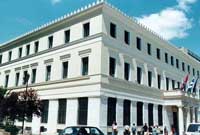 |
|
ATHENS CITY HALL
Three-storied building of austere morphological elements. The marble propylon at the entrance is one of the characteristic elements of the building while the ground floor is also covered with marble and the openings in between are filled with decorating ironworks. The main entrance has a marble door-frame that ends to a decorating marble jamb. |
|
| The stories are separated by a long cornice. Characteristic element of the facet is the marble balcony. When the City of Athens
got a 130,000 drachmas loan by the National Bank of Greece, it decided to built the Municipal Mansion on the last remaining area from the people's garden, on the western side of Athinas Street. The architectural study was given to the architect P. Kalkos (during the mayoralty of P.
Kyriakou) and in October 1872 the construction started to finish less than two years later in May 1874.
Originally, the building was two-story high, built in a strict neoclassic style. In 1901, during the mayoralty of S. Mercouris, restoration and decoration works were conducted. In 1937 the second floor was added.
By a ministerial decree of 1989, the building was identified as a historical preserved monument since it is considered to be important for the study of the architectural history and the city-planning development of the city and because it consists a characteristic place of reference for the lives of the people of Athens.
|
|
ILIOU MELATHRON (MANSION)
Iliou Melathron (Mansion) "Iliou Melathron" was the residence of Heinrich Schliemann, the German archaeologist and great friend of Greece. The building, built in 1879, is surrounded by a garden embracing its three sides. Its ground plan has an almost quadrangle outline of 23 x 25 meters and a twin monumental staircase on the northern side. |
|
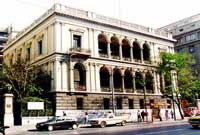 |
|
| The facade is decorated from down to two-stories upwards by rows of Ionian style columns. The interior has been affluently garnished by "Pompeian" wall paintings and other decorative wall and ceiling illustrations. It is considered to be the best Renaissance-style work of Hernest
Ziller. As it happens with many others of Ziller's works, the structure of the facets in a "base-body-crowning" design is also evident in Iliou Melathron, in accordance with the classicism's principle of "horizontalization." The building is a representative sample of the mature Greek Neoclassicism and was once the most luxurious private edifice of
Athens -a huge amount of money was spent back then for its construction.
In 1927 it was purchased by the Greek State and housed the Supreme Court. Now, it houses the Numismatic Museum. The works conducted by the Ministry of Culture's Directorate of Museum Works Conduction for its full restoration are about to be completed soon. Works are also conducted for the conservation of the wall-paintings and other decorations as it happens for the reformation of the building to serve as a Museum.
By a ministerial decree of 1952, the building was identified as "in need of special protection" according to the relevant 1950 Law. |
|
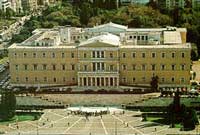 |
|
THE PARLIAMENT BUILDING (OLD PALACE)
A representative sample of the early period of Neoclassicism in Greece, the building is an abstemious work of strict geometry in its mass. The formation of its spaces forms a frame and a central rectangular body that separates the opening in between in two courtyards. Doric-style column rows stand in front of the facade and |
|
| the back (eastern) side. It was built between 1836 and 1840 based on the study of the Bavarian architect Fr. Goertner. Originally it served as a palace of Otho, the first King of Greece after the end of the Turkish occupation, who moved from Nauplion (initial royal seat and temporary capital of the Hellenic State) to
Athens in 1834. The expenses of its construction were carried out by Otho's father, King Ludwig of Bavaria, who financed the project as a personal loan to his son.
The Greek state expropriated the estates occupied by the building, the front plaza and the royal garden. The first Parliament was temporarily housed in a private residence building in Kolokotronis Street while afterwards it moved to the University building and much later, in 1857, to the building of Stadiou Street that houses today the Museum of History and Ethnography.
In 1884 and 1909 the building suffered damages in fire and in 1910 was abandoned by the royal family. It was then remodeled to house the Hellenic Parliament in 1930, by the architect A. Kriezis and finally in 1935 the National Assembly moved in.
Today, it serves still as the seat of the Hellenic Parliament and houses offices, the National Assembly Room, the office of the president of the Assembly, the Archives and other services. By a ministerial decree of 1952, the building was identified as "in need of special protection" according to the relevant 1950 Law. |
|
UNIVERSITY OF ATHENS
The National and Kapodistrian University of Athens
The University of Athens forms part of the so-called "Neoclassical Trilogy" of the City of Athens: Academy - University - Library. It consists of a group of built masses that shape up a double "T", with two symmetrical courtyards. The facade is strictly symmetrical to the arcade of rectangular pillars, set-off by an Ionian-style entrance. |
|
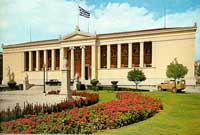 |
|
| The bases of the columns and the capitals of the entrance are perfect replicas of the equivalent found in the Propylaea of Acropolis. The building follows the basic aesthetic rules of early Neoclassicism, while at the same time is adapted to the Greek Mediterranean climate. The outside statues complete the entrance's composition, that is evidently distinguished to "base," body" and "crowning" parts.
Today the building serves as headquarters of the University of Athens, housing the offices of the Rectorate, the Juridical Department, the Archives and the Ceremonial Hall for official ceremonies of national esteem that refer to the University community. By a ministerial decree of 1952, the building was identified as preserved monument "in need of special protection" according to the relevant 1950 Law. |
|
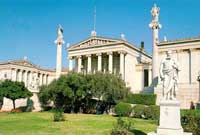 |
|
THE ACADEMY OF ATHENS
The Academy of Athens forms part of the so-called "Neoclassical Trilogy" of the City of Athens: Academy - University - Library. It consists of aesthetically distinct parts that form a harmonic ensemble of built mass. A corridor connects the two lateral wings to the main body of the building, which -in its proportions of line and |
|
| mass- is set-off by its Ionian-style entrance and its big pediment. The entrance has elements originating from the eastern side of Erechteion, on Acropolis. The predominant material on the facets is marble. Overall, the building is a characteristic example of mature Neoclassicism. |
|
|
 |
|
|
|